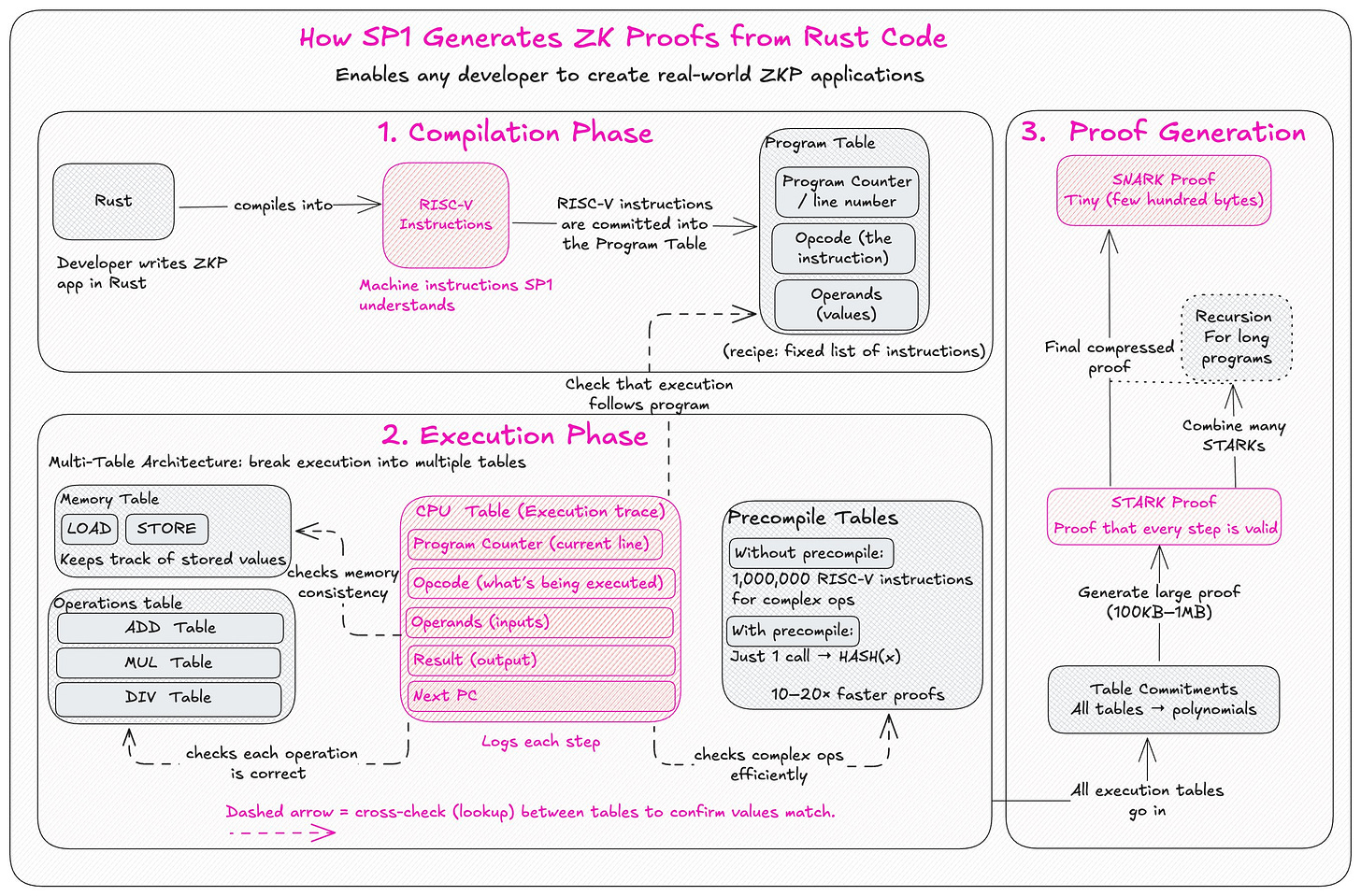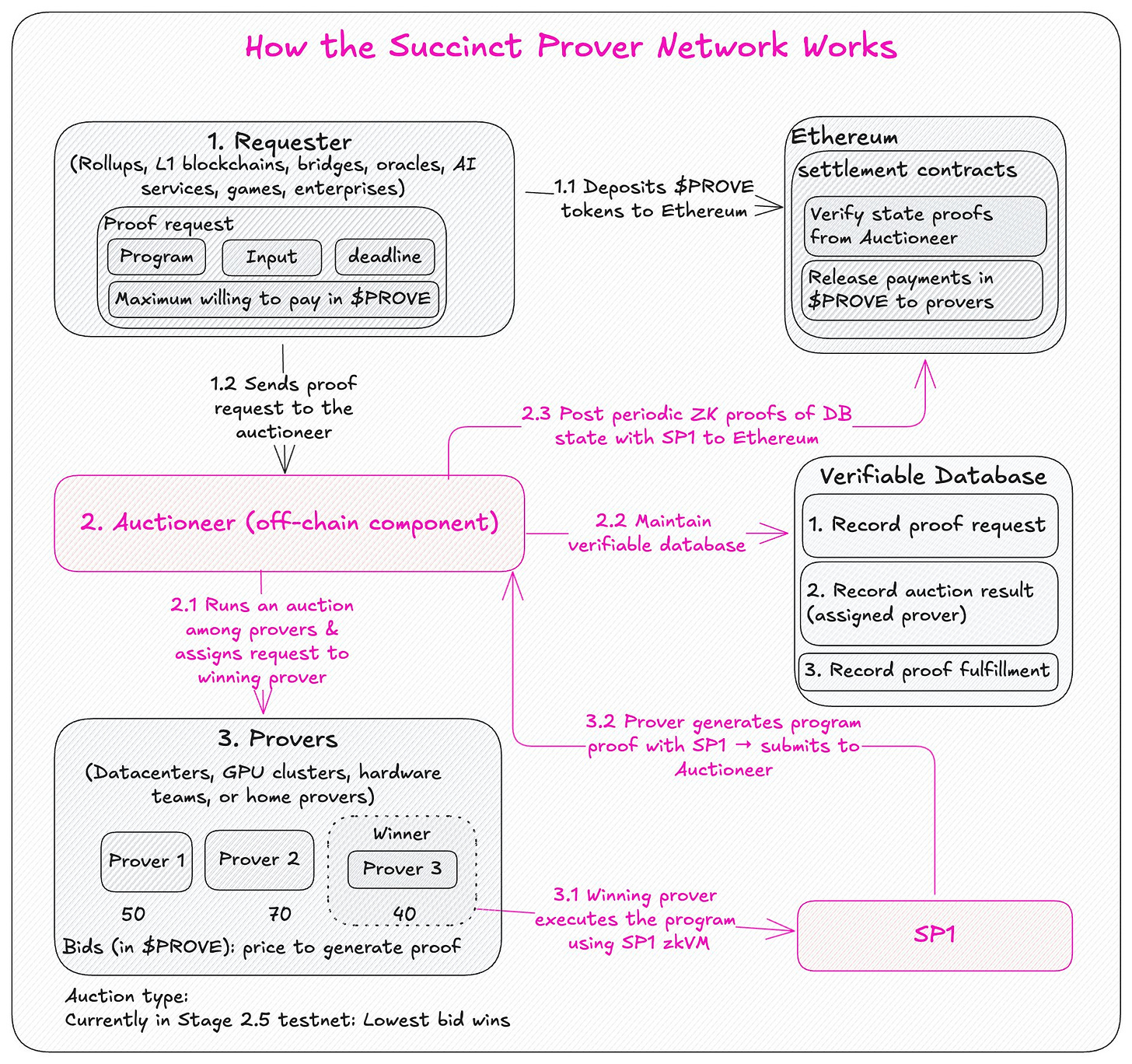Succinct Labs: What is the difference between SP1 and SPN?
Demystifying SP1 and the Succinct Prover Network (SPN) and understanding when to use what.
Part I. SP1 zkVM
1. What is SP1?
SP1 zkVM stands for "Succinct Processor 1 Zero-Knowledge Virtual Machine."
Think of it as a special computer that not only runs your program but also creates mathematical proof that it ran correctly.
2. Before SP1:
Want a ZK proof? Write complex cryptographic circuits manually (like doing calculus by hand)
Want to verify someone's computation? Re-run their entire program yourself (slow & expensive)
No trust without verification: either trust blindly or waste resources re-computing
3. After SP1:
Just write normal code, SP1 handles the cryptography
Get mathematical proof of correctness, no need for others to re-run anything
Verify proofs in milliseconds instead of re-running hours/days of computation
Enables any developer to create real-world ZKP applications by writing code in Rust
Makes ZK accessible to regular developers, not just cryptography PhDs
4. How SP1 Works
Write code in Rust → compiles it into RISC-V instructions
Program Table is created → a fixed recipe of all instructions
Execution Phase → CPU runs the program step by step, checking each instruction with special tables (ADD, MUL, memory, etc.)
Proof Generation → all tables are turned into math constraints to build a STARK proof that the execution was valid.
Final Compression → for long programs, proofs are combined and compressed into a tiny SNARK proof that blockchains can verify.
5. Key Innovations
Lookup-centric architecture: Tables specialize and cross-verify each other
Precompiles: 10-50x speedup for crypto operations (Ethereum blocks: 10B cycles → 200M cycles)
Efficient recursion: Combines multiple proofs into one final proof
STARK to SNARK: Compresses large proofs (STARK) into tiny ones (SNARK) Ethereum can verify
6. Use Cases
ZK Rollups: Turn optimistic rollups into zk rollups with faster withdrawals (~1 hour vs 7 days).
ZK Light Clients: Build blockchain bridges that rely on proofs of consensus, not multisigs.
DeFi Solvency Proofs: Exchanges prove assets ≥ liabilities without revealing balances.
Identity Proofs: Prove properties like “over 18” without sharing private data.
General Compute: Off-chain tasks, machine learning inference, or data validation with zk proofs.
7. Live Use Cases
OP Succinct, built on SP1 zkVM, cuts Optimistic Rollup finality from 7 days to ~1 hour.
Mantle is the first OP Stack L2 to launch as a ZK Validity Rollup with 1-hour finality, 12-hour withdrawals.
Part II. Difference between SP1 and SPN.
1. What is Succinct Prover Network (SPN)?
A decentralized network that proves software using zk proofs.
Think of it as a marketplace: apps (like rollups, bridges, AI agents) need proofs — Provers (people with GPUs, data centers, or even home hardware) generate those proofs.
2. What's the actualy difference between SP1 and SPN?
SP1 solves the software side of proving: you write normal Rust code, it compiles to RISC-V, and SP1 produces the ZK proof.
Running SP1 on your laptop would be slow and costly.
For that, there is Succinct Prover Network solves this by coordinating a global cluster of provers, datacenters, GPU farms, and even home GPUs, to deliver proofs faster and cheaper.
3. Actors Involved
Requesters: rollups, blockchains, bridges, AI agents, games
Provers: teams with GPUs, servers, or specialized hardware to generate proofs
Delegators: Regular users who don’t run hardware but can stake their $PROVE
Auctioneer: service that coordinates requests and provers
Ethereum settlement contracts: hold all funds, check the Auctioneer’s proofs, pay out provers and delegators, and slash provers if they fail.
4. System Workflow
A requester deposits $PROVE on Ethereum and submits a proof request.
The Auctioneer runs an auction among provers.
Provers place bids.
The winning prover runs SP1 zkVM and generates the proof.
The proof is sent to the Auctioneer, which records it in its database.
The Auctioneer proves its database state with SP1 and posts that proof to Ethereum.
Ethereum verifies the update and pays the prover (and any delegators who backed them).
Status today (Stage 2.5 testnet): reverse auction system (the lowest bid wins).
5. What Changes at Mainnet
PROVE goes live → payments, staking, and slashing have real economic weight.
Proof contests (probabilistic inclusion) → instead of one winner, several provers can submit.
Delegation opens fully → anyone can back a prover, helping them qualify for jobs and earning part of the rewards.
Bigger scale → Data centers, ASIC/FPGA teams, and proving pools of home GPUs join, making SPN the largest proving cluster in the world.




